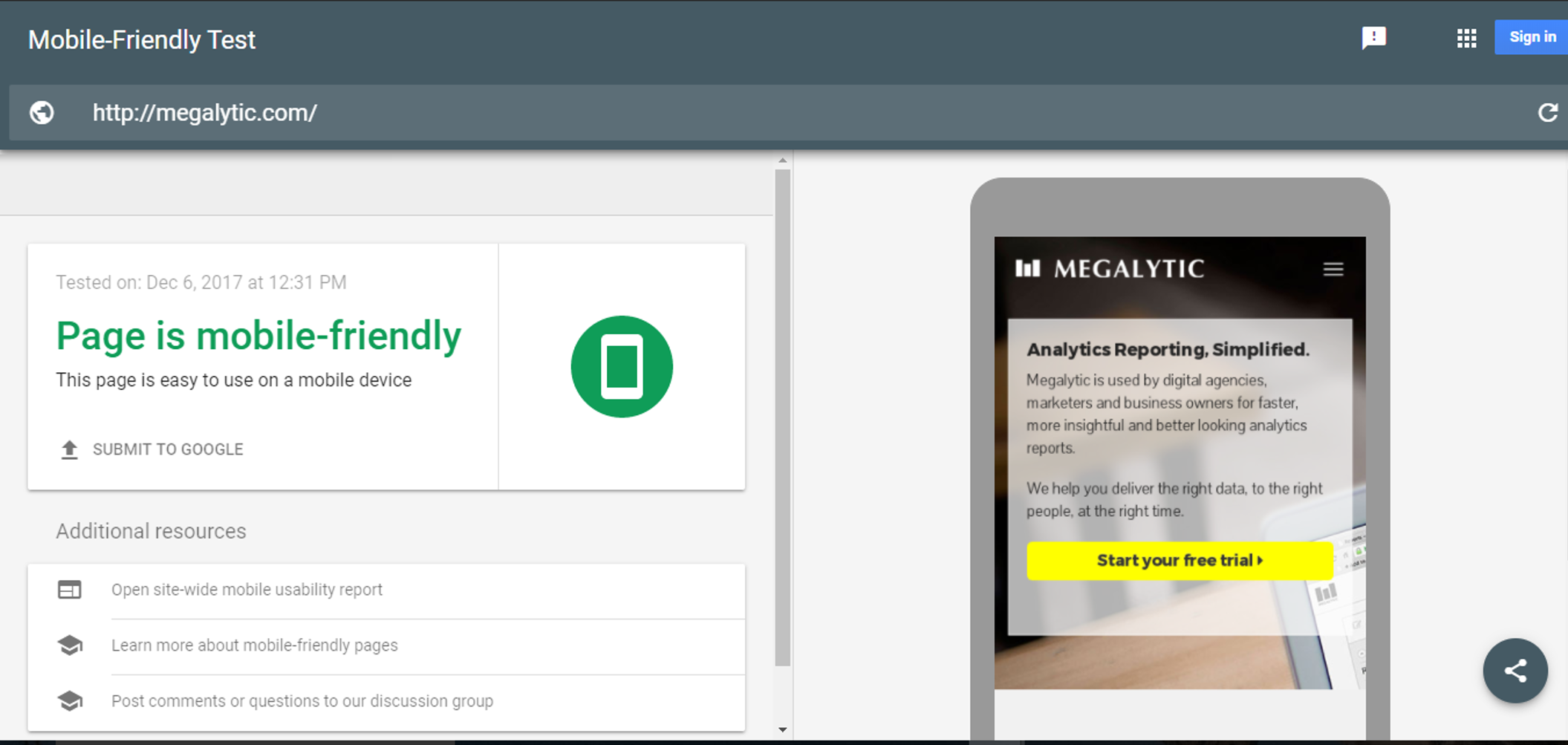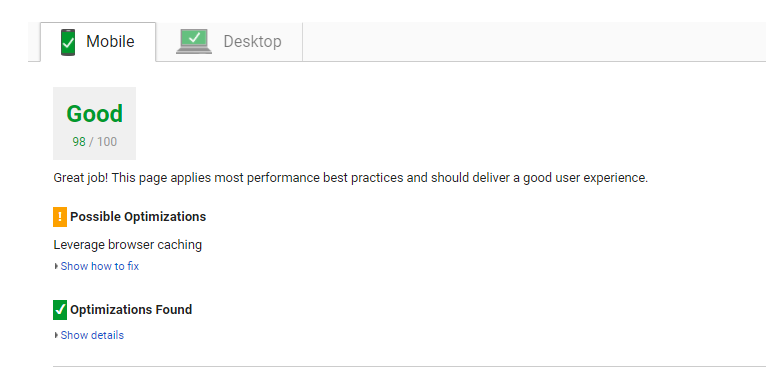- By 2018, US users are spending up to 5 hours a day on mobile devices Techcrunch
- More than half of mobile device users reach for their smartphones immediately after they wake up. ExpressPigeon
- Last year, approximately 43% of worldwide website traffic was from mobile phones. This in an increase of about 12% over 2015. Statista
Mobile Friendliness
The first question every business must ask should be “is my website mobile-friendly?” To answer that question Google and Bing have provided handy little checkers.
Google Mobile-Friendly Test
Bing Mobile-Friendliness Test Tool
Hooray we’re mobile-friendly! But to be fair, “passing” these tests is little more than the baseline of acceptability while a fail is an imperative for action. A “failing” site may receive warnings like:
- Content wider than screen
- Small font size
- Clickable elements too close together
These issues aren’t necessarily related to indexing or Google’s ability to access, crawl, and interpret these pages with the Googlebot smartphone user agent. But rather, they reflect Google’s user-centric dogma. All of these recommendations are related to how websites appear to users and relate to factors that might inhibit a visitor’s ease of interaction with the site. The volume of mobile access and the growing share of mobile traffic for websites across verticals means that, search engines aside, a website which does not have the minimum level of mobile-friendliness is likely losing visitors, and conversions, simply by creating a frustrating mobile user experience.
But even if you do pass, it’s not necessarily a free pass to relax. There are multiple ways to serve website content on a mobile device. Those include:
- A responsive site where the design changes based on user behavior or screen size.
- Dynamic content which uses the same URLs but changes content based on the device accessing it.
- Mobile specific URLs which may include an m. subdomain or an /m/ directory. These sites serve different URLs and content to users depending on the device they are using.
To help keep the finer points straight, Google offers this little table:
Which one should you use? Well, in their post on a future mobile-first index Google states that “If you have a responsive site or a dynamic serving site where the primary content and markup is equivalent across mobile and desktop, you shouldn’t have to change anything.” Google does recommend a responsive site which keeps URLs and HTML consistent regardless of the user’s device. This may be related to the continuity responsiveness provides as while dynamic serving relies on user agent detection which could be prone to errors.
Also, when it comes to organic search factors like incoming links and page content are influential factors. If mobile URLs and mobile content are different in a mobile-first index, these pages could lose positioning. If the page signals which are associated with relevance and authority are different between mobile and desktop, and weaker on mobile, it could have a detrimental effect on organic search visibility.
Given the rise of mobile, Google’s recommendation and the growing consumer imperative of omnichannel consistency, if at all possible, making a website responsive is likely the most proactive and forward-thinking choice.
Page Load Speed
When you get past the design, the other major element to consider with regard to mobile friendliness and search is speed. It’s been several years since Google announced that page speed was considered as a ranking factor
And just last year, a Google representative noted that mobile page speed wasn’t negatively impacting sites in search, at the moment, but he also warned that would likely be changing sooner rather than later.
Moving forward we can expect to see page speed as a ranking factor on both desktop and mobile but why does that matter so much? Largely because we as a body of users are not accustomed or inclined to wait for our content. Here are a few of the speed related highlights from research by DoubleClick , which is owned by Google.
- The average load time for mobile sites (on a 3G network) is 19 seconds.
- Websites that beat the average, achieving a load time of about 5 seconds can see 35% lower bounce rates and up to 70% longer average sessions.
- But the real kicker? 53% of visits to mobile sites are abandoned if the page does not load after 3 seconds.
Mobile web users are taking a page from Ricky Bobby’s book here, they wanna go fast.
In addition to a mobile friendly testing tool, Google also offers the PageSpeed Insights tool.
This test helps site owners determine how well optimized a page is to load quickly. For results that return a “poor” or “needs work” result, Google offers some standard recommendations which include:
- Leverage browser caching
- Optimize images
- Reduce server response time
- Minify JavaScript
- Eliminate render-blocking JavaScript and CSS in above-the-fold content
They will also provide specific examples of resources on a site that fit into each optimization category. While the results and recommendations here may be imperfect because it will identify factors over which a webmaster has no control. For example, leveraging a browser cache for JavaScript elements which are controlled by Google Analytics or Facebook.
But the tool can be helpful in bringing attention to major, fixable issue. Like pointing out specific images where compressing and resizing can result in a significant reduction. With this tool, it’s best not chase a “perfect score” but rather use it as the name suggests, for insights.
There are a number of ways to get a faster site that range from using a content delivery network (CDN) to updating or reducing plug-ins. The key is to find the right combination of speed increasing tactics which apply to a site’s composition and functional needs. While there is no “one size fits all solution” the mandate is clear for all, mobile first index aside, today’s websites need to speed it up.
Conclusion – It’s All About The User Experience
Both mobile friendliness and page load speed are and will continue to be important organic search factors and will become even more significant as Google heads toward a mobile-first index. Preparing for this shift means getting on board with both of these factors as site requirements rather than site enhancements. But from a higher level strategic perspective the theme here is providing the best possible mobile user experience. In a sense, this is merely a logical continuation of the existing directive to provide the best possible content and user experience to site visitors in order to remain competitive. A mobile-first index might sound intimidating, but with the right considerations and preparation, this change can actually present an opportunity to seize a competitive advantage.




